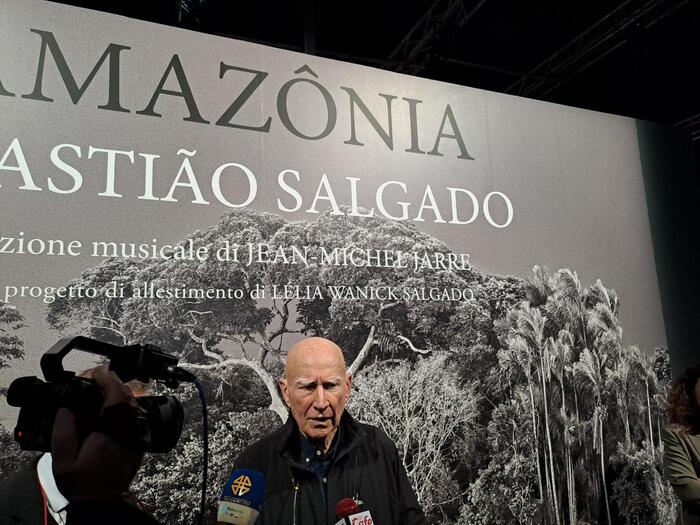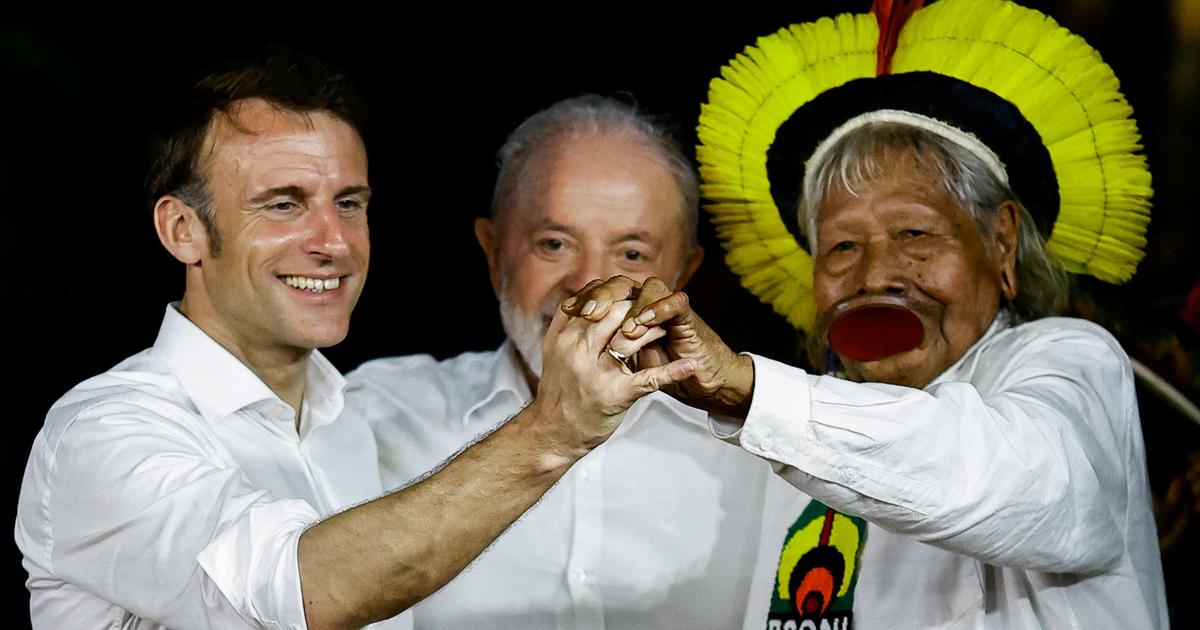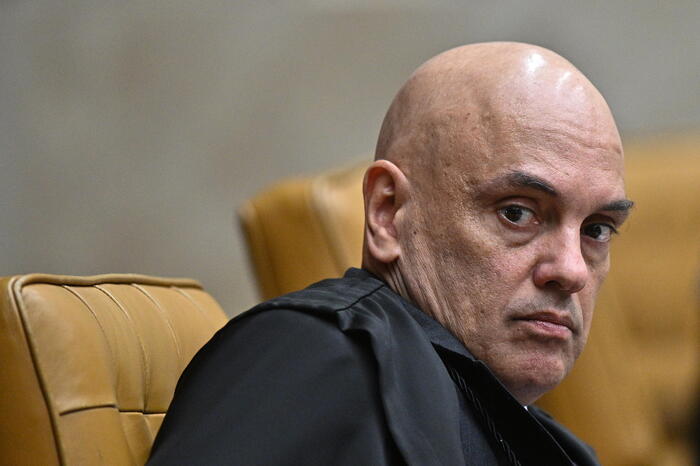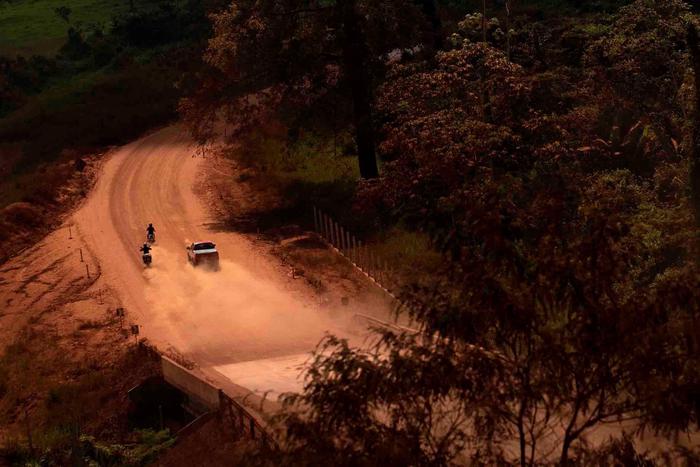Discovering Brazil requires having a detailed map at hand, but in much of its immense territory those kilometers are irrelevant: what counts is the time needed to travel them and reach the destination.
On this occasion, the objective is an enclave to discover the universe of uncontacted indigenous people: Atalaia do Norte, a city located in a corner of the western Brazilian Amazon.
Here are both those who protect them and those who threaten them.
And it is the starting point for those who obtain authorization to enter the Yavarí Valley indigenous reserve, which is home to more isolated natives than anywhere else on the planet.
Getting there requires flying to Manaus to connect with the only daily flight to Tabatinga, 1,000 kilometers to the west.
And from there,
a river taxi through the waters of the Amazon River and, later, another land taxi to our destination.
But only when we arrived at the hotel, and saw the map of the area hanging in reception, did we become aware that those last two hours by taxi represented a ridiculous distance when compared to the immensity of the valley to which it leads and the mysteries of the beings that inhabit it.
The way
They set out by boat, continued by canoe, and then advanced on foot, hacking their way through vegetation that from the air is like dark green carpet.
Beneath her, the towering trees plunged the 30 people of this expedition into darkness, which had an exceptional mission: for the first time in three decades, a team from the organization created to protect the indigenous people of Brazil entered the Amazon more intact in search of a tribe never contacted by whites.
They were looking for some korubo, a splinter from a group that had come out of seclusion four years earlier.
Why locate them?
Because their fights with the Kanamari were increasingly violent: murders, kidnappings, revenge attacks.
It was a special situation even for Bruno Pereira, the 57-year-old indigenous veteran who coordinated that expedition of the National Indian Foundation (Funai) in 2019, because it represented an exception to the policy of absolute respect for indigenous people who want to live without relationship with strangers.
"It was not an easy decision.
It was a taboo," says Pereira: "We went looking for them to defuse the conflict.
And out of respect for those (korubo) who wanted to meet their relatives.”
First they found two young men.
“They got very scared, they were hunting with huge blowguns.
After a few hours they went to look for the rest.
They were 32″, recalls the indigenista.
The korubo accompanying the officials staged an emotional reunion with their families.
"We suggested they get vaccinated," he says.
There, in the middle of the jungle, they explained that this liquid would protect them against various evils.
They accepted.
They were also shown on a computer aerial photos of the village in which they recognized each other one by one.
Soon, the most daring wanted to go for a ride in the helicopter, says Pereira in Atalaia do Norte, a city that leads into the Yavarí Valley.
Nowhere else on the planet do so many uncontacted Indians (by whites) live as in this valley located in western Brazil,
Above
, the indigenous land of the Yavarí Valley, seen from a plane.
Nowhere else on the planet are so many uncontacted tribes concentrated.
There are 10 confirmed and six more under study.
Below
Right
, the Brazilian city of Atalaia do Norte, on the banks of the Yavarí River, a tributary of the Amazon.
Deep in the jungle, encounters with strangers entail extreme tension until you know if they are friend or foe.
Half a century after coming face to face with a white man for the first time, Ivanrapa Matis, 58, still remembers the fear he felt at that moment.
He was nine years old.
There were several of them and they came in peace, but that was not clear at first.
Thanks to his father, he knew they existed and had even glimpsed them once, felling trees or aboard boats ten times larger than canoes.
This indigenous man remembers an idyllic childhood, without serious illnesses and going out to hunt with tiny spears that his father made for him.
"We learned by imitating the elders, it was like a game, we went to hunt macaques," he says.
At that time, what really terrified him was not the whites, but the revenge of other tribes, he explains now in Atalaia do Norte.
Matis —a man who makes gestures as if shooting an arrow or chasing an animal— is an extraordinary witness to one of the most unique experiences that has most fascinated anthropologists and adventurers throughout history.
Five centuries after the Portuguese conquered Brazil and exterminated or decimated countless tribes, more than a thousand indigenous people resist all contact.
The figure is pure estimation.
They are small groups, a few dozen people who move with great stealth, vigilant, almost always invisible.
The jungle - a hostile habitat like few others for any outsider - is all the universe they need.
It is enough for them to feed themselves, heal themselves, build families or have fun.
The Yavarí Valley is home to a true anthropological heritage, a mosaic of cultures about which little is known.
The multiple threats that lie in wait for him include the usual ones — diseases or missionaries — and newer ones: drug trafficking and Jair Bolsonaro.
We know for a fact that there are at least ten uncontacted tribes in the Yavarí Valley, an indigenous reserve larger than the entire territory of Panama.
Of six other tribes there are stories, rumours, sightings... unconfirmed.
In all of Brazil there are 28 confirmed uncontacted peoples and indications of another 86 are being studied. More than in any other country.
With the mission of protecting them, a constellation of indigenous people in close collaboration with indigenous people integrated into society and NGOs work hard in the depths of the jungle or in court.
First, prove that they exist.
But, most importantly, without contacting them.
That is the official policy of Brazil since 1987: watch over them without interfering, except in extreme cases.
An approach that President Bolsonaro undermines by weakening Funai.
Critics accuse the far-right of putting this official body at the service of the interests of those who want to deplete the largest tropical forest in the world.
The contact
Ivanrapa Matis continues his story, which is translated by a young Matis (indigenous people use their tribe's name as their surname).
When they lived without contact with strangers, they hunted in groups, ate together from the same ceramic pot and drank a fermented drink,
caiçuma
.
“Our mothers told us: 'Be careful with the snakes, with the jaguars'.
They still say it,” he says.
They shared a large
maloca
(communal hut) where each family had some privacy.
“The husband's hammock was on top, and the wife's, below.
Next door they had a fire and they slept there with the children”, he recounts.
Later, he hangs his monkey tooth necklace, earrings, and shell nose ornament to pose on the banks of the Yavarí, a tributary of the Amazon.
Meanwhile, his wife, Koka Matis, weaves a hammock by hand.
Koka, wife of Ivanrapa Matis, weaves a hammock by hand.Avener Prado
Ivanrapa Matis's father was the first to speak to the strangers.
After the scare, he returned to the village with the report, an axe, a machete and a dog.
A treasure that, even today, can revolutionize the life of anyone in the jungle.
Seven other indigenous people approached the visitors, and then four more… The distrust began to dissolve.
"It was like that, little by little."
They made new requests: aluminum pots, matches, flashlight... A relationship began that grew closer.
And as an adult, Matis closed the circle by participating in Funai expeditions.
Knowing the moment of the encounter is an invaluable contribution for these sensitive missions.
People like Matis are crucial in calming terrified natives or preventing an exchange of shots and arrows.
He proudly recalls that he accompanied the most prestigious indigenist in Brazil,
“Our mothers told us: 'Watch out for snakes, jaguars.'
They still say it
Ivanrapa Matis (58), who grew up to the age of nine with an uncontacted tribe and as an adult participated in expeditions to protect other isolated tribes.
Today he lives in a house on stilts near the Yavarí River.
Misunderstandings that end in tragedy are rare these days, but they do happen.
That the veteran civil servant Rieli Franciscato, 56, fell dead in 2020 from an arrow wound left the world in shock.
“I think they confused him because he was with armed policemen,” explains indigenous woman Neidinha Suruí, 62, on the phone from Porto Velho (Rondonia state).
“When you go through the jungle, you don't see them, but they do see you.
What they don't know is if you are from Funai, from an NGO or what your intentions are”.
Franciscato, who directed one of Funai's ethno-environmental protection fronts, tried to confirm the presence of uncontacted indigenous people in an area of Rondonia to prevent clashes with local peasants who invaded their lands, harassment that suffocated them.
A few months before Franciscato's death, the indigenous people visited a farm.
They left hunting pieces and took a machete.
For specialists, a friendly barter.
It is believed that they were isolated from the Cautário River.
When almost nothing is known about them, the reference is the nearest river.
Among the most besieged, the Piripkura, so called because they move like butterflies.
There are only two left in the jungle, uncle and nephew.
Survivors of a massacre, they have never wanted to leave their plot of jungle, which is getting smaller and smaller due to the illegal expansion of agricultural estates.
But in 2016 they deviated from their routes to approach a government surveillance post.
They were looking for fire.
His torch, glowing for years despite torrential rains, had gone out.
The tenderness of their meeting with the Funai official who watches over them, Jair Candor, 61, who is in charge of confirming each year that they are still alive, is moving.
Together they star in the documentary
Piripkura
(Amazon Prime), where they are seen leaving days later with their torch smoking again.
The isolated are survivors of epidemics or massacres, beings always alert, traumatized.
When their lives become a constant flight, they often stop procreating, cultivating.
If the tribe itself abandons its isolation, it is because it sees no alternative, because it is the only option for survival, experts explain.
Anthropologist Conrado Octavio, 38, knows the Yavarí Valley well thanks to his former job for the Centro Trabalhista Indigenista, an NGO that supports Funai on expeditions.
Like most experts, he is irritated by the romantic image of exotic beings living as in the Neolithic.
As if the jungle were an Eden of happy prehistoric people.
“They are groups that opt for other ways of life, but they are as contemporary as we are.
We are also making decisions all the time, making collective agreements and facing emergencies, conflicts or crises.
Only that they have other paths and solutions”, he explains in a café in Rio de Janeiro.
The isolated are the minority of the minority.
Forecasts from the 1970s that indigenous peoples would generally become extinct have not been fulfilled.
They make up 0.5% of Brazilians, a million people from 256 tribes, which entails an uncommon linguistic, cultural and anthropological wealth.
Seven out of ten live in villages.
Any Internet user can browse the complete database of the NGO Instituto Socioambiental.
The natives do not remember a Brazilian president as openly anti-indigenous as this one.
A professional provocateur, Bolsonaro stirred them up by placing an evangelical missionary at the forefront of official policy towards the uncontacted and recently awarded himself the indigenist medal of merit.
the expeditions
Beto Marubo, born 47 years ago in a village, has spent half his life defending the isolated groups that inhabit the 85,000 square kilometers of Yavarí indigenous land.
He protects them on several fronts: as a lobbyist in Brasilia, deep in the jungle, at international events or from his Twitter account.
These days he is in Atalaia do Norte to plan projects and take a trip to a remote village called Lobo.
An inexhaustible source of stories about adventures in the jungle, Marubo stopped by a Funai expedition years ago to investigate rumors that some poachers had perpetrated a massacre of isolated Korubos.
For days they advanced without stopping sweating, sleeping in hammocks, enduring bites, until they discovered children's footprints on a river beach.
“They were footprints of two-year-olds.
They were collecting turtle eggs.
When the relative (as the Indians refer to other Indians) is frightened, he does not bring children or women.
So the slaughter was not there, ”he recounts while pointing to points on a map.
We are at the headquarters of Univaja (União dos Povos Indigenas do Vale do Javari), an association that is a small miracle: the seven local ethnic groups put aside ancestral hatreds to defend the land together.
The next day they found a recently trodden path, took it and, they found them!
“They were fishing with fish killer poison,” a method they use when they travel, he explains.
One of the indigenous people –guide and translator– understood.
It didn't take long for the expeditionaries to find out that the natives had discovered them.
“When we picked up the drone, there were the relatives, a bunch, sharpening the arrows.
We took the boat and left.
The expedition ended there”, says Marubo.
Mission accomplished.
Killing ruled out.
The Korubo were still there.
“Interethnic relations are not so friendly.
People believe that all Indians are the same.
And no"
The indigenist Beto Marubo (47), representative of the Univaja association, which brings together the indigenous people of the Yavarí Valley.
Marubo remembers the curiosity of an old man about those huge and noisy devices that flew over the village, once sporadic and now frequent.
He told her that "they are like canoes that fly, full of whites"
Over the decades, the Funai lookout posts changed their mission and name.
The attraction fronts became contact fronts, and are now called ethno-environmental protection fronts.
Only the State (ie Funai) can undertake expeditions on indigenous lands.
Organizing them always involved strict quarantines and a great logistical effort.
Although overflights and satellite images now make monitoring easier, it is still vital to go deep into the jungle in search of clues.
The trade requires physical and mental stamina, endless doses of patience, and detective skills.
Only those who have a highly trained eye can see traces in the midst of so much visual and sound stimulation: broken twigs in a bush that isolated indigenous people leave to get their bearings or a honeycomb from which they have already taken the honey in inaccessible places.
With that, as if they were forensic, the indigenists verify that they exist, how many there are —thanks to the size of the cabins or orchards— or how many days ago they passed through that point.
Naming them is not easy either.
The most widespread terminology is "uncontacted", but that means without contact with us, with the whites.
And, as the indigenista Marubo emphasizes, isolation is never total.
They know they are not alone in the world.
Sooner or later there are encounters, more or less punctual, more or less hostile.
“Interethnic relations are not so friendly.
But people believe that all Indians are the same.
And no".
The current policy of not intervening was born when verifying that after the first meeting the deaths multiplied, explains Pereira, coordinator of that exceptional mission of 2019. This former director of the isolated department of Funai says that, “until 1987, the official policy was to attract them.
The Amazon was being cleared, roads were being built, hydroelectric plants... but after a few months they died of diseases, they did not have a good diet.
It was the destruction of their social structure.
There the philosophy of the State changes to a policy of no contact.
And it became a world reference.
Peoples who had resisted for centuries succumbed to the flu, measles, malaria or tuberculosis.
The last plague, that of covid-19, killed 900 indigenous people in the villages.
With Bolsonaro, Funai is experiencing an exodus of technicians.
Pereira is one of the fallen from grace.
He was already on unpaid leave when Funai denounced him for conflict of interest.
He accuses him of coordinating inspections of the indigenous people.
The threats
The landing of the colonizers in America decimated the natives and forever disrupted the lives of the survivors.
In the 20th century they were unceremoniously expelled from their land to make way for progress that came in the form of telegraph lines, highways or hydroelectric plants.
Who knows how many groups disappeared from the face of the earth with no record of their name, their culture or their worldview.
And why should we protect them?
The indigenista Pereira answers: “First, because they have the right to live and they don't know anything about what the law is, our humanity, our civilization.
I believe that humanity advances when it understands that these minorities also have the right to exist.”
The range of threats is wide: gangs of fishermen and poachers, evangelical missionaries, gold prospectors, drug trafficking, agricultural expansion, the coronavirus and, since Bolsonaro came to power, Funai itself, according to NGOs.
There were always poachers who entered the indigenous reserve.
The novelty is that now they are authentic organized gangs, denounces the Univaja association.
The pirarucú, a precious Amazonian fish that weighs up to 300 kilos, has become a highly sought-after delicacy, especially in neighboring Colombia.
Atalaia do Norte market, where some residents belong to gangs dedicated to fishing and poaching in the Yavarí valley indigenous land. Avener Prado
"I know it's wrong to go to indigenous land, but there are no other opportunities here," complains Alacy, 23, who hides her identity under that pseudonym to protect herself.
Her argument is that taking advantage of that manna is the only option to make a living in a city like Atalaia do Norte, where only the City Hall and the Department of Health offer good jobs.
"And the rest, what does he live on?", Launches this young father of two children who left behind a past of a lot of alcohol and a pistol on his belt.
As his river taxi driver's license and his training as a bricklayer have never served to feed his family, he embarks for weeks with several colleagues, a shotgun and a shipment of salt with which they preserve the loot.
The poachers are so many that sometimes they enter a
stream
(an arm of the river) and run into another two or three boats.
This is not an issue that is openly discussed with outsiders in Atalaia do Norte, and even less so the day after a police operation that, thanks to information gathered by the indigenous people, ended with two detainees and the seizure of dozens of pirarucú, turtles and other wild animals.
It is a small town where everyone knows each other.
Every morning the torrential rains puddle some unpaved streets where a church rises every few meters (the evangelical quadrangular, the seventh-day adventists, the assembly of god, the fundamentalist….).
Emulating the Jesuits who arrived with the colonizers 500 years ago, contemporary missionaries arrive here looking for impure souls.
Atalaia do Norte is a mecca for evangelicals who believe that Jesus will only return to earth when the truth has been revealed to all its inhabitants, including isolated indigenous people.
The New Tribes Mission is the most famous and controversial.
For decades he has sent American missionary couples, flouting the law, to places never before seen by whites.
Above
, sculpture of Saint Sebastian, patron saint of Atalaia do Norte.
Below
To the left
, churches of different evangelical denominations in the city of Atalaia do Norte.
The coronavirus and the risk of contagion were the ideal situation for an indigenous lawyer to get a judge to expel a missionary couple who had been living in the Yavarí reserve for decades.
In recent times soul hunters have adopted a more sophisticated strategy: giving scholarships to young indigenous people to study theology in big cities.
Then they return to their villages to preach.
Josiah McIntyre, 38, is a Christian from Alabama (USA) who settled in the Amazon more than a decade ago.
Now he is accompanied by his wife and his four children.
"I already know what they say about me," he comments, denying that his intention is to evangelize the uncontacted, although some local sources suggest that they have heard him proclaim that he wants to die under arrows as a martyr.
“I am in Atalaia do Norte to preach the truth, to teach young people to do the right thing because here there are a lot of drugs, alcohol, pornography…”.
To keep them away from these temptations, he organizes races of up to 8 kilometers, an incentive for kids in a city where entertainment is scarce.
They can't even get away with YouTube or Instagram: the connection is dire.
The drug has indeed arrived.
Important drug routes cross the triple border.
One of the many concerns of Kora Kanamary, 37, is that traffickers recruit young indigenous people to grow coca in Peruvian territory.
Some even participate in the processing.
The temptation is great because they have few lawful ways of earning a living.
This member of the Univaja association leads a team of 36 forest guardians that monitor the territory to stop loggers and large-scale agriculture.
Marubo, Kanamari and the rest of their colleagues embody a major change in the policy of protecting the uncontacted.
The indigenous people themselves assume increasingly relevant functions in the face of the vacuum left by the withdrawal of Funai since one of its officials was assassinated shortly after Bolsonaro began his mandate.
They combine the knowledge of their ancestors with science and technology.
They patrol the reserve with training and tools donated by WWF, an NGO, to better document their complaints.
They now know how to read and make maps, and on their rounds in the field they use satellite-connected mobile phones that allow them to easily record coordinates and countless details.
Above
, evangelical Christian missionary Josiah McIntyre, wearing a headscarf.
The woman in the center is his wife.
Bottom
Right
, Kora Kanamari, 37, indigenous leader of the Javarí Valley and representative of Univaja.
Those who watch over the uncontacted feel that, under Bolsonaro's orders, the Funai leadership has abandoned its mission to instead serve the interests of political and economic sectors that see the tribes as an obstacle to development.
Before the UN, the president of Brazil left his position clear: “Unfortunately, some inside and outside Brazil, supported by NGOs, insist on keeping our indigenous people as true cavemen (...).
The Indian does not want to be a poor landowner on top of the richest land in the world”.
The far-right, who despises the climate crisis, is determined to authorize the exploitation of territories untouchable by law.
For this reason, the pulse in Congress and in the courts on indigenous and environmental issues is formidable.
One of the hottest fronts concerns seven territories where isolated tribes live, but which, as they have not been demarcated as indigenous reserves, are protected by an emergency mechanism that prevents unauthorized entry.
But with the Bolsonaro government, the validity of these measures has been shortened, warns Survival International.
The last ones have been renewed for only six months.
Sarah Shenker, from this organization, explains that “uncontacted indigenous peoples do not simply disappear from the earth, as some believe;
it is not his destiny, nor a chronological certainty.
It is a deliberate and genocidal process by governments and companies that want to eliminate them to steal their land and profit, a process driven by international demand for wood, gold, oil and other resources.
Shenker mentions, by video call from London, their invaluable contribution as protectors of the jungle.
The lands where they live conserve vegetation and biodiversity in an abundance without comparison.
The complaints against the Funai of Bolsonaro are multiplying.
One of his monitoring teams recently discovered traces of an unknown tribe near the Purus River (Amazonas), without the body adopting any precautionary protection measures, according to several alarmed indigenous organizations.
Funai says it is investigating the signs.
The transition
Contact usually gives way to a long transition.
Each town decides at what pace and in what direction.
Anthropologist Dominique Gallois, 71, is well aware of the intense dialogue with the newly contacted.
She was the first to study the Zo'é in the jungle, in 1989, a couple of years after some missionaries went looking for them.
"When I arrived there were 170, there were few children," he explains at his home in São Roque, near São Paulo.
Easily recognizable by the fashion cone embedded in the lower lip they wear, the Zo'é live in a remote area even in Brazilian terms.
The two weeks of hiking in the nineties is six days because they have opened trails.
That distance has protected this group in which young wives hunt with their husbands.
“The Zo'é are in this wonderful situation because access is very difficult.
But there are already paths…”, she warns.
Gallois accumulates long stays, conversing in their language, sleeping in their huts, eating their food — “you can't take anything from outside, sugar would be deadly” — and taking notes in notebooks.
Commissioned by Funai, Gallois worked for three years hand in hand with the Zo'é and Funai official Fabio Ribeiro, 39, to develop a plan on how they want to manage their lives, which they have captured in 140 pages .
The Kanamari Indians go to Atalaia do Norte to get money and solve bureaucratic procedures.
The journey home is by boat and can take more than a week.Avener Prado
Step by step they addressed countless issues – from land to money – in a dialogue that requires diplomacy and devilish logistics.
Ribeiro, now executive coordinator of the OPI (an NGO, the Observatory of Isolated Peoples), explains that “all the State's action is adapted to its seasonal calendar.
Even a vaccination campaign is complicated because you have to gather 300 people in one place.
They come from a score of distant villages up to 40 kilometers away.
We talk a lot on the radio because if you organize it badly you interrupt its activities”.
Satisfied the most immediate needs, this people of oral culture wanted to learn to read and write.
And they are at it, becoming literate in their language, with the help of Gallois and his Anthropology students.
The teaching materials, which come and go by plane, are based on their daily life.
Mr. Matis, who grew up without contact with whites, has been away from home for months.
A temporary job for Funai – creating a sanitary barrier against covid – has brought him to Atalaia do Norte, but as soon as he can he will return to his village, located, he explains, “three days without sleeping” in
pec-pec
, a canoe light with a small motor.
In this vast territory, the rivers are the main means of transport.
And the distances are measured based on the horsepower of the outboard motor.
For the most privileged, aerotaxis.
Matis complains about the heat of the city —“there are no trees here to provide shade”— and the constant hubbub of motorbikes and cars.
“I prefer to live in the village.
We go hunting, fishing.
That's another world, you don't buy there.
Living here is very difficult, you need money.”
Exclusive content for subscribers
read without limits
subscribe
I'm already a subscriber






/cloudfront-eu-central-1.images.arcpublishing.com/prisa/FO2F5WJG7FGW7DM7VPOOYNFMFI.jpeg)








